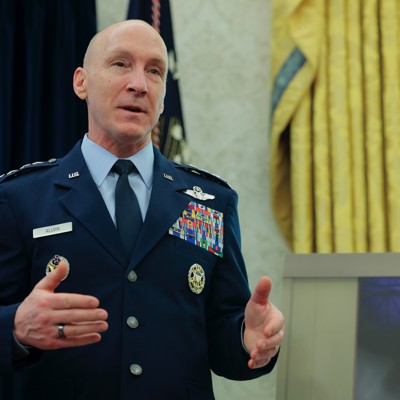Air Force Chief Gen. David Allvin’s abrupt retirement wasn’t driven by Defense Secretary Pete Hegseth, but by growing frustration with the service’s priorities, according to multiple people familiar with the decision.
On Monday, Allvin announced his plans to retire after serving just two years as the service’s highest-ranking officer, typically a four-year job. No reason was given in the Air Force press release that contained his announcement.
The first months of the second Trump administration have seen an unprecedented purge of senior military officers. In February, Hegseth fired the chairman of the Joint Chiefs of Staff; Allvin’s vice chief, Gen. James Slife; the chief of naval operations; and the judge advocates general of the Army, Navy, and Air Force. Others removed later include the commandant of the U.S. Coast Guard, the commander of NSA/U.S. Cyber Command, and the Pentagon’s representative to the NATO Military Committee.
But this time around, Hegseth did not play a role in the departure, according to an Air Force official.
Rather, the decision stemmed from a desire to move away from plans for a service-wide reorganization, an effort former Air Force Secretary Frank Kendall had pushed. Ultimately, the effort, called “Reoptimizing for Great Power Competition,” was seen as something too tied to the last administration and a potential distraction while the service deals with bigger problems.
The numerous reorganization initiatives were “more distracting than they are helpful” since the Air Force is struggling with all-time-low readiness rates and manning problems, according to one person familiar with the discussions.
For example, a hallmark of the reoptimization effort was to build “deployable combat wings” that would train and deploy together as one unit, while a separate garrison wing would handle core Air Force functions and maintain the military base.
But the service doesn’t have enough manpower or resources to divide up the wings at every location, one former defense official said, and senior commanders were more concerned with the readiness of their aging equipment and dwindling fleet sizes.
Parts of the reorganization effort will likely get axed or altered once a new chief is picked. An Air Force spokesperson said that no final decisions have been made regarding the effort, and provided no timeline for a decision.
Allvin was informed last week that he would be asked to retire and as a trade-off he would be allowed to announce his retirement, the Washington Post reported Tuesday. In a press release, the service said he will continue to serve until a replacement is confirmed by the Senate.
A new chief has yet to be officially announced, but Gen. Kenneth Wilsbach is on the top of the list of contenders, Breaking Defense first reported and Defense One confirmed. Wilsbach served as head of Air Combat Command and commander of Pacific Air Forces. He stepped down from ACC on Aug. 11 and announced his intent to retire and hand over the reins to Gen. Adrian Spain.
Read the full article here

